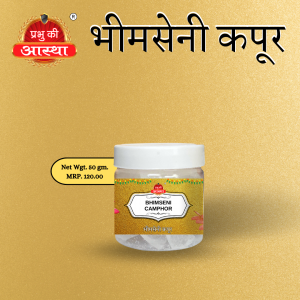CAMPHOR
-
 Read more
Read moreKapur, also known as camphor, is a waxy, white substance that is derived from the wood of the camphor tree. It is commonly used in Hindu religious ceremonies as an offering to the gods and goddesses. Kapur is believed to have a purifying effect and is often burned on charcoal or placed in small burners to release its fragrant aroma. In addition to its use in religious ceremonies, Kapur is also used in traditional medicine for its medicinal properties. It is believed to have anti-inflammatory and analgesic effects and is used to treat a variety of conditions such as coughs, colds, and skin irritations. However, it is important to note that Kapur can be toxic if ingested or used in excessive amounts, and should only be used under the guidance of a healthcare professional. Despite its potential risks, Kapur remains an important part of Hindu culture and is widely used in spiritual and medicinal practices.
-
 Read more
Read moreKapur, also known as camphor, is a waxy, white substance that is derived from the wood of the camphor tree. It is commonly used in Hindu religious ceremonies as an offering to the gods and goddesses. Kapur is believed to have a purifying effect and is often burned on charcoal or placed in small burners to release its fragrant aroma. In addition to its use in religious ceremonies, Kapur is also used in traditional medicine for its medicinal properties. It is believed to have anti-inflammatory and analgesic effects and is used to treat a variety of conditions such as coughs, colds, and skin irritations. However, it is important to note that Kapur can be toxic if ingested or used in excessive amounts, and should only be used under the guidance of a healthcare professional. Despite its potential risks, Kapur remains an important part of Hindu culture and is widely used in spiritual and medicinal practices.
-
 Read more
Read moreKapur, also known as camphor, is a waxy, white substance that is derived from the wood of the camphor tree. It is commonly used in Hindu religious ceremonies as an offering to the gods and goddesses. Kapur is believed to have a purifying effect and is often burned on charcoal or placed in small burners to release its fragrant aroma. In addition to its use in religious ceremonies, Kapur is also used in traditional medicine for its medicinal properties. It is believed to have anti-inflammatory and analgesic effects and is used to treat a variety of conditions such as coughs, colds, and skin irritations. However, it is important to note that Kapur can be toxic if ingested or used in excessive amounts, and should only be used under the guidance of a healthcare professional. Despite its potential risks, Kapur remains an important part of Hindu culture and is widely used in spiritual and medicinal practices.
-
 Read more
Read moreKapur, also known as camphor, is a waxy, white substance that is derived from the wood of the camphor tree. It is commonly used in Hindu religious ceremonies as an offering to the gods and goddesses. Kapur is believed to have a purifying effect and is often burned on charcoal or placed in small burners to release its fragrant aroma. In addition to its use in religious ceremonies, Kapur is also used in traditional medicine for its medicinal properties. It is believed to have anti-inflammatory and analgesic effects and is used to treat a variety of conditions such as coughs, colds, and skin irritations. However, it is important to note that Kapur can be toxic if ingested or used in excessive amounts, and should only be used under the guidance of a healthcare professional. Despite its potential risks, Kapur remains an important part of Hindu culture and is widely used in spiritual and medicinal practices.
-
 Read more
Read moreKapur, also known as camphor, is a waxy, white substance that is derived from the wood of the camphor tree. It is commonly used in Hindu religious ceremonies as an offering to the gods and goddesses. Kapur is believed to have a purifying effect and is often burned on charcoal or placed in small burners to release its fragrant aroma. In addition to its use in religious ceremonies, Kapur is also used in traditional medicine for its medicinal properties. It is believed to have anti-inflammatory and analgesic effects and is used to treat a variety of conditions such as coughs, colds, and skin irritations. However, it is important to note that Kapur can be toxic if ingested or used in excessive amounts, and should only be used under the guidance of a healthcare professional. Despite its potential risks, Kapur remains an important part of Hindu culture and is widely used in spiritual and medicinal practices.
-
 Read more
Read moreKapur, also known as camphor, is a waxy, white substance that is derived from the wood of the camphor tree. It is commonly used in Hindu religious ceremonies as an offering to the gods and goddesses. Kapur is believed to have a purifying effect and is often burned on charcoal or placed in small burners to release its fragrant aroma. In addition to its use in religious ceremonies, Kapur is also used in traditional medicine for its medicinal properties. It is believed to have anti-inflammatory and analgesic effects and is used to treat a variety of conditions such as coughs, colds, and skin irritations. However, it is important to note that Kapur can be toxic if ingested or used in excessive amounts, and should only be used under the guidance of a healthcare professional. Despite its potential risks, Kapur remains an important part of Hindu culture and is widely used in spiritual and medicinal practices.
-
 Read more
Read moreBhimseni Kapoor, also known as camphor, is a white crystalline substance with a strong, pungent odor that is commonly used in religious ceremonies and as an ingredient in various medicines. It is derived from the camphor tree, which is native to Asia, and has been used for thousands of years for its medicinal and aromatic properties. Bhimseni Kapoor is widely used in Hindu religious ceremonies as a sacred substance that is believed to have purifying and sacred properties. It is burned as incense, placed on offerings, and used in a variety of rituals. In addition to its use in religious ceremonies, Bhimseni Kapoor is also used in traditional medicine to treat a variety of health conditions, such as coughs, colds, and muscle pain. However, it is important to use Bhimseni Kapoor under the guidance of a healthcare professional, as it can be toxic if ingested or used improperly. Despite its potential risks, Bhimseni Kapoor remains an important part of Hindu culture and spirituality, and is widely used in religious and spiritual practices.
-
 Read more
Read moreBhimseni Kapoor, also known as camphor, is a white crystalline substance with a strong, pungent odor that is commonly used in religious ceremonies and as an ingredient in various medicines. It is derived from the camphor tree, which is native to Asia, and has been used for thousands of years for its medicinal and aromatic properties. Bhimseni Kapoor is widely used in Hindu religious ceremonies as a sacred substance that is believed to have purifying and sacred properties. It is burned as incense, placed on offerings, and used in a variety of rituals. In addition to its use in religious ceremonies, Bhimseni Kapoor is also used in traditional medicine to treat a variety of health conditions, such as coughs, colds, and muscle pain. However, it is important to use Bhimseni Kapoor under the guidance of a healthcare professional, as it can be toxic if ingested or used improperly. Despite its potential risks, Bhimseni Kapoor remains an important part of Hindu culture and spirituality, and is widely used in religious and spiritual practices.

